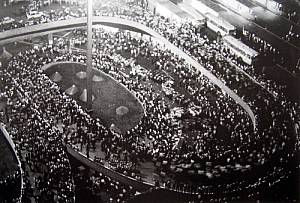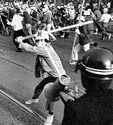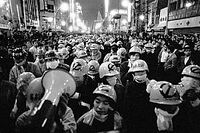Summer of Freedom
| Summer of Freedom | |||
|---|---|---|---|
 Mass of protesters occupying an overpass in Hirakawa | |||
| Date | May 1968 – November 1969 | ||
| Location | |||
| Methods | Occupations, wildcat strikes, general strikes, riots | ||
| Resulted in |
| ||
| Parties to the civil conflict | |||
| |||
| Lead figures | |||
| |||
The Summer of Freedom (Miranian: 自由の夏 Jiyū no natsu; Gothic: 𐍆𐍂𐌹𐌾𐌴𐌹𐌽𐍃 𐌰𐍃𐌰𐌽𐍃 Frijeins asans), also referred to as the Summer of Chaos (Miranian: 混乱由の夏 Konran no natsu; Gothic: 𐍃𐌰ᚴ𐌾𐍉𐌽𐍃 𐌰𐍃𐌰𐌽𐍃 Sakjōns asans) and the National Struggle (Miranian: 国民闘争 Kokumin tōsō; Gothic: 𐌸𐌹𐌿𐌳𐍉𐍃 𐍃𐌰ᚴ𐌾𐍉 þiudōs sakjō), was a period of civil unrest that occured in Akashi in 1968–1969.
A series of student protests in May 1968 escalated into occupations and sympathy strikes, which spread rapidly and widely. When police action only inflamed the situation further, the Yurika Ehara government followed a restrained course, refusing to suppress the unrest by force.
The unrest channelled a mood of alienation and frustration with Akashian life, and the carnivalesque mood of the protests was notable. The protesters had both concrete goals and impossibilist ones. When the Zenrōkyō concluded the Shiomi Accords, winning significant wage gains, its membership ousted the leadership and destroyed the organisation, forming the Sōhyō instead and launching the country's first wildcat general strike.
At the movement's zenith, the economy of Akashi had ground to a halt, the national government ceased to function, large parts of cities had been "liberated" by protesters, and the country appeared on the verge of revolution or another civil war. Yurikara formed a national unity government and introduced numerous reforms to address protesters' grievances, including a constitutional referendum in June 1969. Factional infighting grew stronger as the protesters mistook the government's restraint for imminent victory, and the movement ran out of steam.
By the time of the 1970 general election, the public had tired of the chaos, propelling the National Union to its last single-party majority. Yurikara's initially controversial tactic of letting the crisis fade away by itself was vindicated, and she won the 1970 presidential election against a "youth revolution" candidate. The severe economic recession caused by the unrest marked the start of the "siege economy" that characterised the 1970s.
The Summer of Freedom marks a turning point in modern Akashian history, succeeding as a social revolution rather than a political one. It brought great changes to Akashian society and helped push the political centre of gravity to the left. The protests have left a mark on the cultural sphere, and have been the subject of popular media.
Background
Political atmosphere
Yurika Ehara had come to power by winning the Akashian Civil War, and had served simultaneously as President and Prime Minister since 1940. Her dominance of the Akashian political scene was transmitted onto her party, the National Union, which won 7 single-party majorities in a row from 1942 to 1970.
The civil war had ended with the right-wing being discredited by its decision to side with the Futurist Political Party, while the left-wing had been exhausted by the fighting, allowing the NU to monopolise the centre ground.
Public frustration with Yurikara's personalised leadership and NU dominance built up. The NU dominance first crumbled at the local level, when it lost the 1960 provincial elections. The formation of the United Opposition in the 1962, although unsuccessful, provided another warning sign.
Decades of left-wing organising began to pay off: the Communist Party was taken over by a younger, left communist generation; the breakaway Workers' Party reunited with the Communist Party in 1967. The Socialist Party, itself under pressure from a more radical youth wing, began a rapprochement with the Communist Party, which included nominating a "united left" candidate for the 1960 presidential election.
Economic conditions
The long economic boom that had begun after the civil war began to peter out in the 1960s. GDP growth declined from a high of 10,77% in 1962 to 4,21% in 1967. The Yurikarist model of state-led development seemed to reach its limits, and some economists warned the country was at risk of falling into the middle income trap.
Although the economic policies of Yurikara and Ayane Saikawa had produced general prosperity and full employment, discontent grew beneath the surface. Yurikara's pursuit of national "grandeur" made her inattentive to increasingly salient quality of life issues. Average working hours trended slightly above the Eracuran average, a legacy of post-war reconstruction. The policy of national champions was increasingly attacked from both the left and right as a corporate welfare scheme. Workers were annoyed with the bureaucratisation and deferential leadership of the Zenrōkyō.
The great expansion of higher education produced a generation of students discontented with the focus on vocational education and the old-fashioned nature of higher education institutions.
Beginning
Student revolt
Disturbances began in May 1968 at the University of Hirakawa, where the students' union had been taken over by radicals. Protests erupted as a result of a discussed medical school reform and demands for greater freedom of expression rights on campus. When the university administration decided to shut down the university, the students occupied the building.
Police attempted to evict students from campus; the scenes of police charging at students and attempting to break the picket line were aired on AKH and caused public revulsion. In response, students at other universities mounted protests in solidarity, and the youth branches of the Communist Party and Socialist Party organised protests at secondary schools. A large march occurred in front of the National Assembly Building, demanding that authorities release arrested students, drop criminal charges, and leave the campus.
The movement spread outside the capital, with student riots and occupations taking place in Mikasa, Mizuho, Rumoi, and Hōrin. By the end of the month, the students had set up the Zenkyōtō (全共闘, short for "All-Campus Joint Struggle Commitees") to coordinate protests. The students managed to occupy the entire University of Hirakawa campus, setting up barricades and declaring it an autonomous "people's university". This brought anarchists to the protests in increasing numbers.
Worker strikes
The demonstrations extended to factories. A general strike on 30 May included a march that attracted some 200.000 workers. The strikes spread to all sectors of the Akashian economy. Across Akashi, students occupied universities and workers occupied factories and workplaces.
The Zenrōkyō tried to channel this spontaneous outbreak of militancy into a demand for higher wages. Representatives of the Zenrōkyō, Keidanren, and the government negotiated the Shiomi Accords, which included a 35% increase in the minimum wage and a 10% increase in average real wages. However, the workers rejected the accords, with scenes of them jeering union leaders, and even beating particularly hated ones, playing across the news.
The membership revolt destroyed the Zenrōkyō. In its place, the workers established the Sōhyō, and continued wildcat strikes. They put forward a more radical agenda, that included reductions of working time, higher salaries, de-bureaucratisation of trade unions, and workers' self-management. Workers occupying their factories erected barricades and changed locks, and formed workers' councils to run the factories themselves.
Character of protests
An alliance between workers and students coalesced, which proved crucial to maintaining the momentum of protests. Coordination between the Zenkyōtō and Sōhyō helped sustain the occupations, and their grievances coalesced into a general protest against life in Akashi.
Although violent clashes with the police and occupations of buildings were widespread, what struck most observers was the carnivalesque atmosphere of the Summer of Freedom. The strong anti-capitalism of the unrest brought a utopian socialist element to the whole movement.
Many of the anarchist and left communist groups that joined with the protesters looked to the example of Gylian anarchists and the far-left insurgency in Delkora, drawing particular inspiration from the Labor Underground's Spaßguerrilla strategy. Protesters used deliberately absurd slogans and chants to ridicule the government and attack capitalism itself, such as "More pay, less work!", and "More good, less bad!".
Students and workers alike produced big-character posters and plastered walls with graffiti bearing revolutionary slogans, ranging from the serious ("Occupy factories!", "All power to workers' councils!", "Death to capitalism!", "Abolish class society!") to the whimsical ("Abolish alienation!", "Abolish boredom!", "Burn cars, ride bicycles!", "Death to cows!", "Ee ja nai ka").
During battles with police, protesters fought with wood or bamboo staves, or shinai and bokutō where available. Many wore helmets as protection. Communist rioters came to be known as "Red Helmets" (赤い兜 Akai kabuto) due to the colour of their helmets or the hammer and sickle depicted on them.
Parties take sides
The spreading unrest put the National Union, the party in power at the time, in the hot seat. The pressure of the protests exposed the NU's weaknesses, particularly its deficient party apparatus as a result of Yurikara's personalised style of leadership. With Yurikara blindsided by the protests, the NU was similarly paralysed, and it began to fracture internally, away from the public eye.
The Communist Party offered a full-throated support of the protesters, having purged its authoritarian socialist wing. The Socialist Party, initially hesitant, backed the protesters as well. The SP convention that year proved to be a tumultuous affair, with fighting on the convention floor, police called in to break up brawls, and a victory of the "revolutionary" faction over the "reformist" one.
Right-wing parties differentiated themselves by attitude towards the protests. While the National Democratic Party and Reform Party deplored the violence, they acknowledged the protesters' grievances and urged immediate reforms to redress them. The Conservative National Party attacked the protests in near-authoritarian terms, calling for "law and order". The Akashi Renewal Party's founder, Ayako Sōnō, called for the military to crush the protests, causing her to be arrested for disturbing the peace and jailed.
Storming of the legislature
When the National Assembly adjourned on 1 June 1968, a crowd of protesters converged onto the National Assembly Building and overpowered the guards. Thousands broke into the building and occupied it for hours, ransacking and vandalising the interior, and putting up barricades and destroying furniture.
The police ultimately deployed tear gas to clear protesters from the building, and in response protesters started fires and threw Molotov cocktails, further damaging the building.
Free AKH
Perhaps the most famous and pivotal event of the Summer of Freedom was the occupation of the AKH office in Hirakawa. A mixed crowd of students, striking workers, and other protesters managed to take over the building, ejecting those who tried to resist, and erected barricades.
Having seized the national public broadcaster, the protesters began broadcasting as "Free AKH" (自由あこほ Jiyū Akoho; 𐍆𐍂𐌹𐌾𐌴𐌹𐌽𐍃 𐌰𐌲𐌰𐍃 Frijeins Agas). Much of the actual broadcasting was handled by journalism and media students, and the barricades and occupation inevitably gave it an amateurish aspect.
Nevertheless, this meant that the protesters now monopolised the largest broadcaster in the country. Broadcasts were strongly anti-government and anti-capitalist. Free AKH also scored high-profile publicity stunts like securing in-person interviews with the DBS Director-General Nikoleta Kušić, leftist theorist Diana Morelli, and Chair of the Common Sphere Economic Commission Gina Campanelli.
Free AKH set an important precedent. Across the country, protesters took to the tactic of seizing control of broadcasting facilities and other media outlets. A spate of attacks on newspapers and party publications ensued, incited by Red Helmets. Typography workers refused to print pro-government or anti-opposition articles.
Zenith
Unrest spread throughout 1968 and into 1969, growing increasingly violent and radical. The far-left and anarchists increasingly pushed protesters towards the goal of destroying capitalism. Protesters disrupted transport and strikes spread to essential services like sanitation and healthcare.
At the height of the unrest, the Akashian economy had ground to a halt. Protesters occupied train stations, blocked roads, and invaded airport grounds, suspending flights. Communications were disrupted, and strikes at power plants caused power outages and rolling blackouts. In cities, protesters declared "liberated quarters" and "autonomous zones". Almost all universities in Akashi were shut down or under occupation, and exams and graduations were suspended.
Increasingly overwhelmed, law enforcement pulled back from many occupied areas. This was a controversial tactic, with the right-wing attacking the government for "caving in" to protesters. However, in the long run, it also encouraged a victory disease among the opposition, as without police to battle, internal rifts came to the surface.
Government collapse
Yurikara had been on a state visit when the Summer of Freedom first escalated, and the intensity of the unrest took her by surprise when she returned to Akashi. Normally self-confident in public, in private her poise faltered as she found herself unable to calm the situation.
How to deal with the unrest caused a fracture within the NU. A "right-wing" faction emerged within the NU that advocated use of force to restore order. This was firmly opposed by Yurikara and her inner circle, the Aku group and Kozue Hidaka. Cabinet meetings grew heated as the two sides argued violently. At one of these, even Kozue lost her composure, yelling "No! No! A hundred years no!" and "Better to see Akashi destroyed than an oni!" to shout down the "right-wingers".
By late 1968, the national government had effectively ceased to function. The 1968 provincial elections and 1969 prefectural elections were heavily disrupted, with workers' councils and "liberated quarters" challenging the local authorities for legitimacy in a dual power operation. The National Assembly was unofficially suspended. Ministers feared that Akashi was on the brink of revolution or civil war. The government couldn't even convince Free AKH to broadcast an appeal for calm.
Yurikara's disappearance
Shaken by the assault on the National Assembly Building, Yurikara left Hirakawa by helicopter. Having told her ministers she was heading to Akanshi, her native village, she changed the course in flight. For nearly 5 weeks, the leader of Akashi's whereabouts were unknown, and her mysterious disappearance stunned the country, while exciting protesters who felt the revolution was within reach.
As it was later revealed, Yurikara secretly headed to Shimachi, and took refuge in a Kisekidō shrine. She was despondent at how far the unrest had spread and horrified at the thought that Akashi would once again erupt in civil war. She would later write in her memoirs that she'd suffered "a nervous breakdown" and needed the isolation to recover.
Váli's Blot riots
On 14 February 1969, the day of Váli's Blot, a radical group called the National Gothic Liberation Front (𐌰𐌻𐌰𐌸𐌹𐌿𐌳𐍉 𐌲𐌿𐍄𐌸𐌹𐌿𐌳𐌰 𐌿𐍃𐌻𐌰𐌿𐍃𐌴𐌹𐌽𐍃 𐍃ᚴ𐌰𐍂𐌰 Alaþiudō Gutþiuda Uslauseins Skara) incited ethnic riots. Goths attacked Miranians in Gothic-majority prefectures and neighbourhoods, in turn causing reprisals from angered crowds of Miranians.
Although the violence died down quickly, the Váli's Blot Riots shocked the public, and marked the first public fracture among protesters. For all the contempt protesters felt towards Yurikara, one of her unquestioned achievements had been quelling the Miranian–Goth ethnic tensions that had contributed to the Akashian Civil War. The riots shattered the peace and raised fears that the "the union of Miranians and Goths" would again unravel.
Infighting weakens the movement
By this point, the public had grown fed up with the chaos and disruptions to daily life. Rural areas in particular turned hostile, angered by the disruption of transport and electricity supplies. The protest movement had hit its ceiling of support, and its window of opportunity was closing.
With law enforcement retreated from active confrontation and unity shattered by the Váli's Blot Riots, factional infighting became rampant. Some protesters took revolutionary extremism to the point of nihilism, forming the "Lunatic Faction" (狂人派 Kyōjin-ha; 𐌰𐌹𐍂𐌶𐌾𐌰 𐌷𐌰𐌽𐍃𐌰 Airzja hansa). The "Lunatics" were devoted to "subjectivity", "self-negation", and "self-criticism", and became a damaging presence, disrupting protesters' activities and engaging in ultra-left sectarianism, attacking others for insufficient revolutionary "purity".
Other rifts emerged as the movement's decentralised nature, previously an advantage, turned against it. Feminists attacked the overly masculine infighting. Communists and socialists began fighting over the end goal of the revolution. The worker–student alliance disintegrated as the "Lunatics" denounced workers as "slaves" to industry.
A new wave of violence was unleashed, this time within the protesters' ranks. Students and workers beat up "Lunatics" and handed them over to the police. The suppression of the "Lunatics" could not repair the broken trust among protesters. The movement became fractured and isolated, each faction ganging up on another and increasingly resorting to calling the police to arrest their opponents.
Barricades broke down and occupations collapsed as the cycle of infighting and arrests allowed police to regain the upper hand. The AKH building was retaken in May 1969. The resumption of normal AKH service shone a harsh spotlight on the disintegrating revolutionary movement.
Decline
The government now regained the upper hand. Yurikara delivered a televised address on 15 May 1969, calling for national reconciliation. The address stunned the public as she broke her self-confident façade and lamented the conflict that engulfed the country, and appeared on the verge of tears as she pleaded, "We few Akashians should never again make each other's noses bleed!".
Yurikara dissolved her cabinet and formed a national unity government to end the crisis, including every party in the National Assembly. She announced a series of reforms to "open up the system", including electoral reform, curbing the presidency's powers, and stronger referendum provisions. Voters approved this package in a constitutional referendum on 28 June 1969.
Further reforms followed, including a radical revision of labour law and university reform. Yurikara declared a partial amnesty, dropping criminal charges against all but the most violent protesters.
The Communist and Socialist parties both made official declarations that "the revolutionary moment has passed" and calling on protesters to stand down. This was an especially bitter pill to swallow for Red Helmets, and led to a highly-publicised hostage crisis in a "mountain base" near Yokoyama.
By the autumn of 1969, the situation on campuses had returned to normal, and public services and transport were restored. The last remnant of the unrest was several occupied factories. Their situation was resolved in November 1969, when the government passed a law that legally expropriated them and turned them over to workers.
Aftermath

The unrest succeeded in forcing Yurikara to retire as Prime Minister. However, it didn't stop her from running for re-election as President. In the 1970 presidential election, her main opponent was Zenkyōtō spokesperson Orime Sasaki, who ran under a "youth revolution" (青年革命 Seinen kakumei; 𐌾𐌿𐌽𐌳𐍉𐍃 𐍅𐌰𐌹𐌷𐌾𐍉𐌽𐍃 Jundōs waihjons) banner. With the other left parties not fielding candidates and the right-wing candidates disqualified by ongoing trials, Yurikara defeated Orime by 55% to 45%. Nevertheless, Orime's better than expected performance showed that Yurikara's popularity was in decline.
The combination of electoral reform and public exhaustion with the protests helped propel the NU to its last majority in the general election. However, this was only a reprieve: the party's internal division had been exposed to the public, and its new leader Masaki Ōshiro simply couldn't match Yurikara's stature.
Although the party had a majority of one seat, Masaki formed a coalition with the Socialist Party and National Cooperative Party to try and shore up his government. The government collapsed as a result of the economic crisis and losing a budget vote in 1972, forcing a snap election that reduced the NU to a medium-sized party, never to recapture its former dominance.
The NU's move to the centre-left was confirmed by the aftermath, with the partial amnesty and expropriation of occupied factories helping secure at least the tolerance of the left, while the arrest and prosecution of right-wing and far-right politicians for disturbing the peace inflamed the right-wing parties.
The unrest caused an economic crisis. The economy contracted by -10% in 1968 and -5,7% in 1969. Although the workers had won a highly favourable revision of labour law, the industrial unrest unleashed by the Sōhyō persisted into the 1970s. Thus, the unrest marks the start of the "siege economy".
Legacy
The Summer of Freedom was a watershed in modern Akashian history. It marked the peak of the counterculture and the emergence of new social movements. It succeeded mainly as a social revolution that accomplished a major transformation of Akashian society, from the democratisation of higher education to great improvements in quality of life and the "opening up" of the political system after a long period of NU dominance.
The unrest ushered in an era of peak influence for the Akashian left, with the crimson and pale crimson blocs collaborating in government during the 1970s, and taking advantage of economic stagnation to pursue radical policies. Despite paltry growth during the decade, the "siege economy" consolidated worker gains, leading to drastic falls in working hours and strong increases in wages due to redistributionist policies.
The Summer of Freedom succeeded in thoroughly associating worker discontent with potential revolution for Akashians that the centre-right governments of Ran Tsukuda and Anna Carbone went out of their way to preserve the gains of the 1970s and secure support from organised labour, and the neoliberal conspiracy stirred such strong public opposition in 1989–1990.
The experience of factional infighting and disintegration of the movement was a bitter lesson for the Akashian left about the importance of unity and coordination. Conflicts persisted for years afterwards over the leftists calling the police on the "Lunatic Faction". The left succeeded at winning the concrete goals proposed initially, while the moralistic nihilism of the "Lunatics" proved a dead-end and a sharp illustration of revolutionary extremism taken to its logical conclusion.
The Summer of Freedom influenced Akashian culture and media greatly, particularly new wave cinema — which, ironically, replicated the arc of rise, peak, running out of steam and disintegration of the protests. The protests have also been the subject of modern popular media, such as the satirical anime series Kill la Kill.




